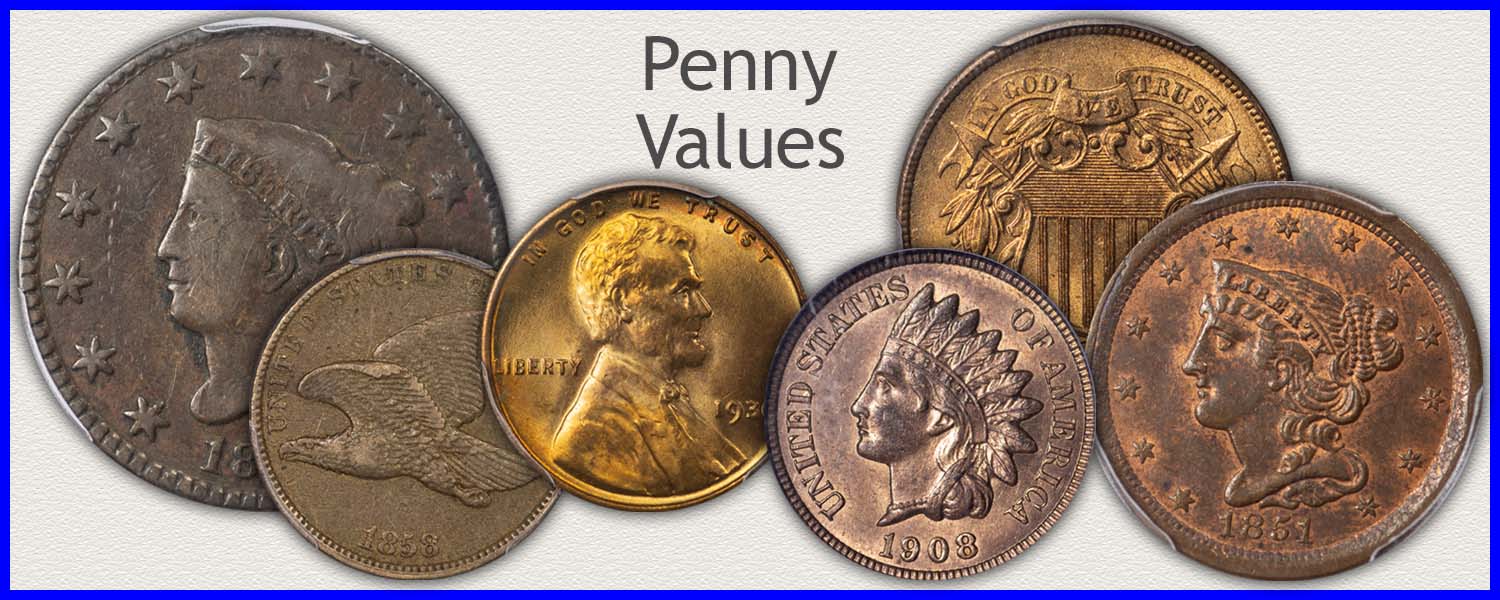Coin Values Moving with Precious Metals: Up-Dated 12/8/2025: Gold $4212 | Silver $58.12
Flying Eagle Penny Values
Flying Eagle penny values are often driven higher by their popularity with a large collector demand. A focus by collectors is date and condition - grade of the coin. Combining and identifying date and condition are key factors to how much these coins are worth.
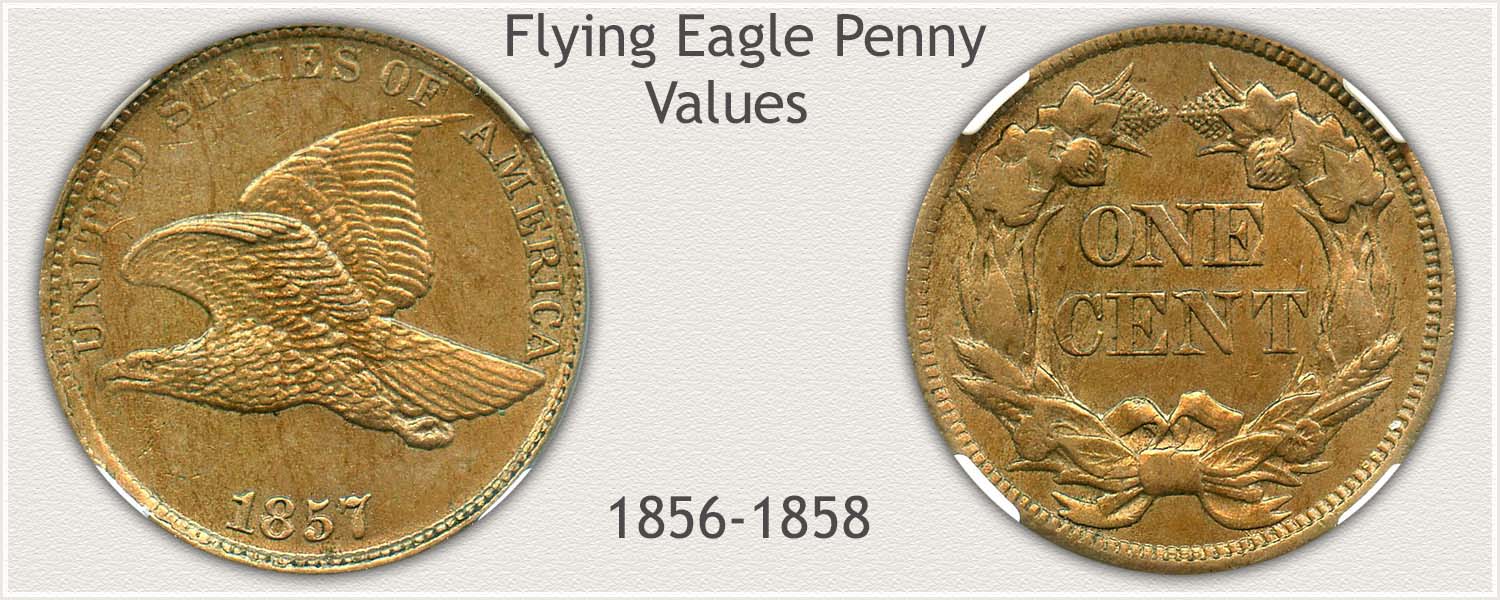
Steps Leading to Value:
- Step 1: Date and Mintmark Variety - Accurately identify three important dates spanning the Flying Eagle cent series.
- Step 2: Grading Condition - Images are compared helping judge condition to arrive at a grade.
- Step 3: Special Qualities - As a new design and size of a one cent coin; a few factors are considered to pin-point value range on chart.
| Flying Eagle Penny Values | ||||
|---|---|---|---|---|
| Condition of Coin | ||||
| Date | Good | Fine | Extremely Fine | Mint State |
| Flying Eagle Penny Values Up-Dated | 2025 | |||
| 1856 | $5,180 | $7,245 | $7,630 | $10,360 |
| 1857 | $24 | $57 | $145 | $443 |
| 1858 | $19 | $33 | $110 | $375 |
Flying Eagle penny values listed are a computed average from dealer's price lists with various wholesale factors figured in. They reflect closely the price you would expect to receive when selling.
Variations in how much your coins are worth do occur subject to subtle grading points, collector demands and dealer needs.
Step 1: | Identify Exact Date of Coin
Three dates are involved, and each is valued separately. The 1856 flying eagle cent is far and away the rarest of this short series, few were minted and fewer still exist today.
Flying Eagle Cent Minted 1856 to 1858
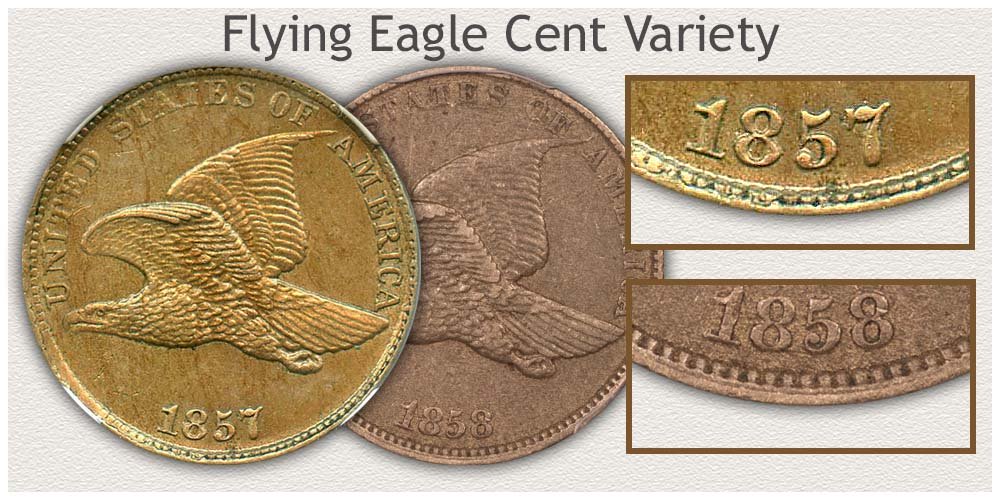
Following the rarity of the 1856 date is the 1857 penny, often found with heavy wear. And the final date, any 1858 penny is collectible, but valued as all old coins, depending on the amount of wear.
1856 through 1858 cents stand out as sought-after collector coins because of the bold flying eagle design. A big departure from the usual Liberty portraits found on other series at the time. Additionally, the Flying Eagle penny was a significant reduction in size from the large cents of prior years. Your old penny pioneered the small cent coins used today. All were minted at the Philadelphia mint.
Step 2: | Judging Condition is Key to Coin Values
Judge your coin's condition carefully and match its appearance to one of the different "grades" imaged. The subtle degrees in wear, or the lack of it, places your coins in a higher or lower value category. Dealers and collectors view coins from a "desirability" point of view and are willing to pay more for coins with the least amount of wear and abuse.
Compare Your Coin to Grading Images and Determine Grade
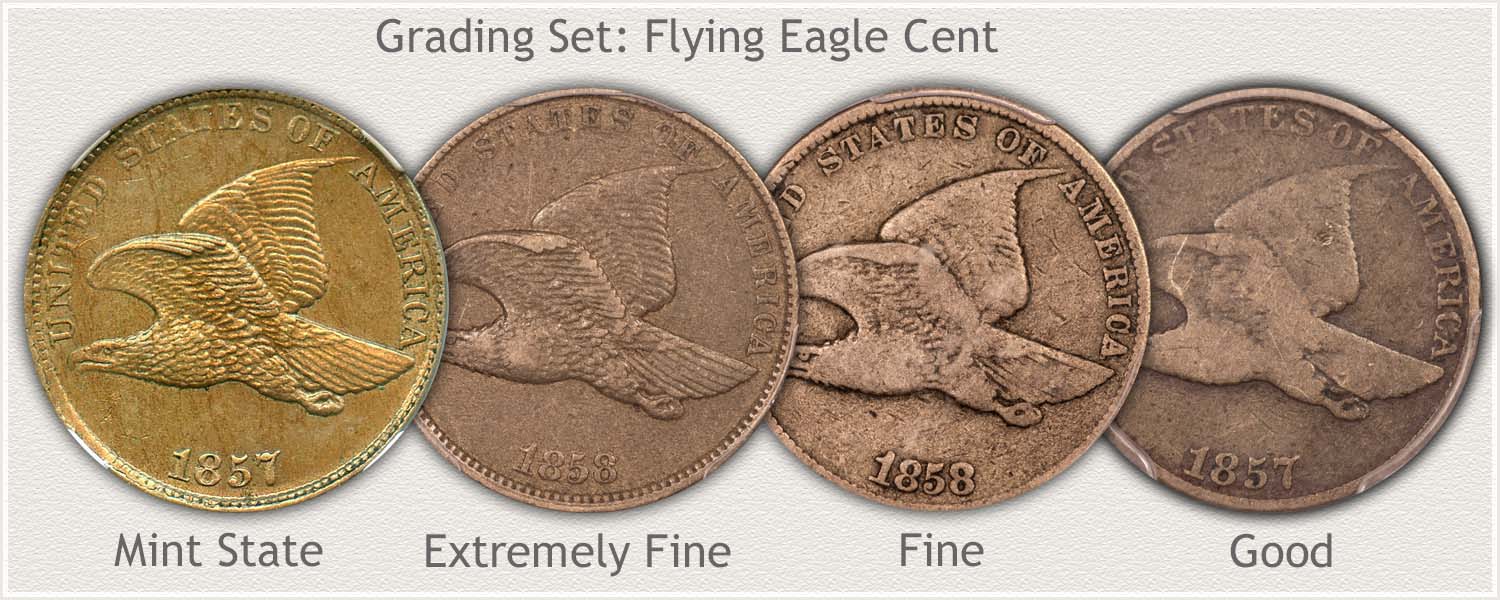
Mint State Grade: Flying Eagle Cent
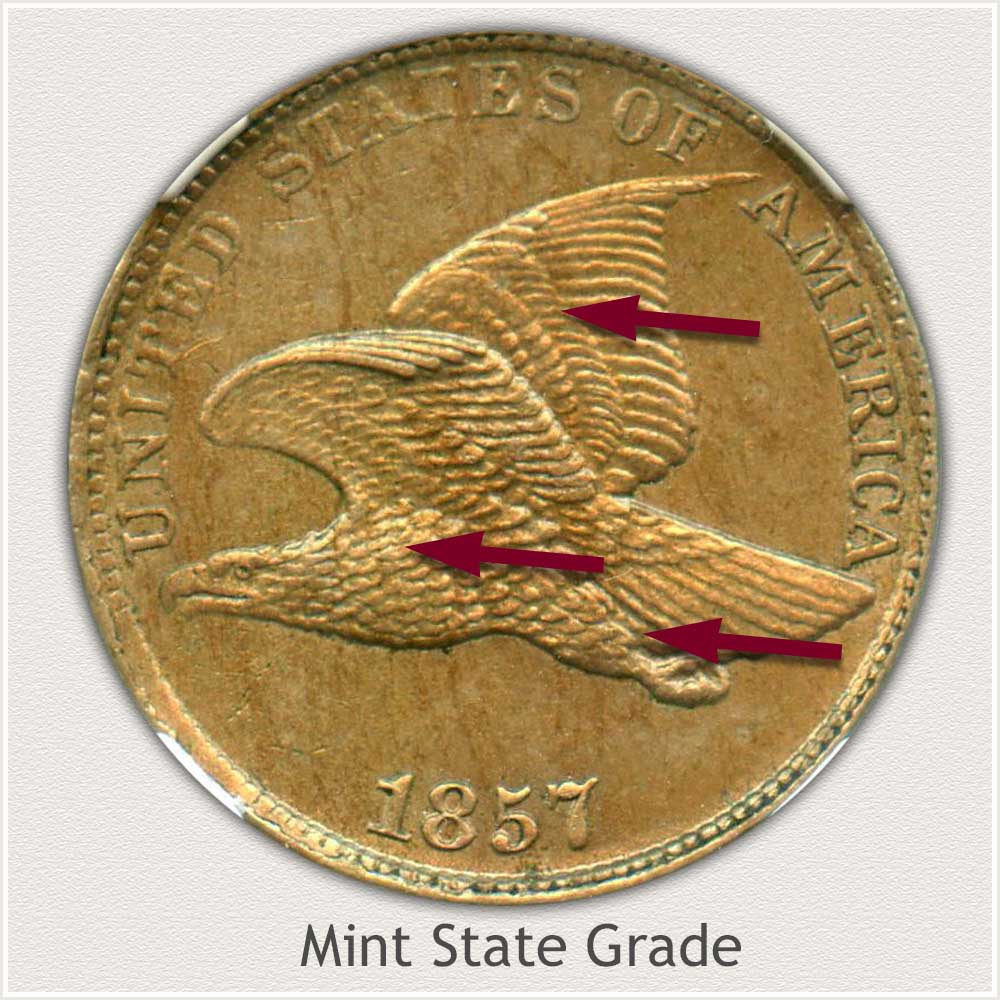
Obverse: Features Identifying Mint State Grade: An eagle in flight fills the obverse. If no wear is present to the surface it qualifies as a mint state - uncirculated coin. A strong symbol of freedom, the eagle is finely detailed with areas susceptible to first signs of wear.
When judging for wear inspect the surface of the feathers on the lower breast just behind the neck feathers. A fine texture to upper edges needs to remain.
A second areas is further back along the lower side of the eagle where the leg begins. High points, featuring dull and smooth surfaces indicate wear.
A further scan of all upper areas of feather lines helps determine no wear is present. These should remain with a texture similar to lower relief areas.
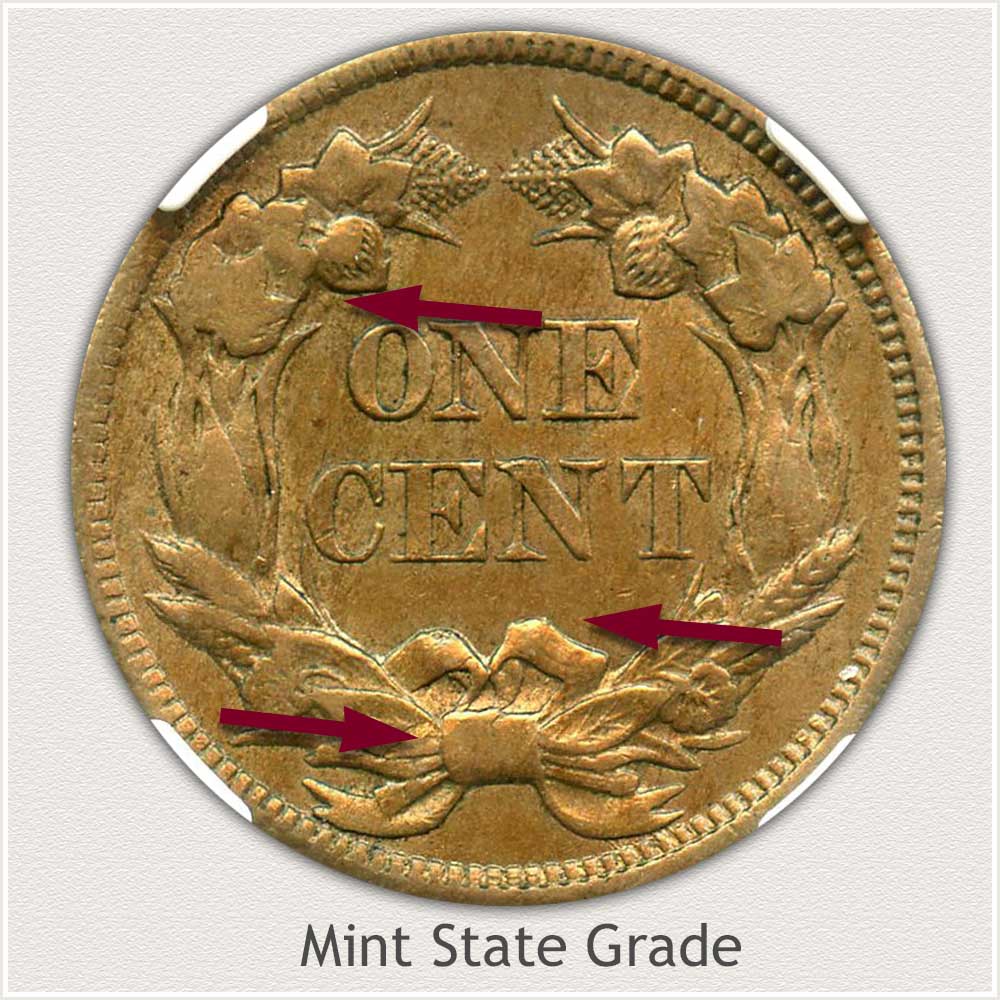
Reverse: Features Identifying Mint State Grade: A bold wreath encircles One Cent. A symbol of victory, important agricultural crops are portrayed, corn, wheat, and cotton are recognizable. All areas of the wreath are without signs of wear on mint state examples.
Leaves on either side of One Cent are high points to the design. A close look are the broad surfaces confirms no smoothing from wear is evident. A slight color change is possible, often the beginning of toning and does not indicate wear. Smoothness to the surface and lack of texture is a clearer indication of wear.
Also high in profile is the bow holding the wreath at the bottom. A knot in the center remains without any smoothing. Upper curls of the ribbon are free of smoothing and help confirm no wear is evident.
Extremely Fine Grade: Flying Eagle Cent
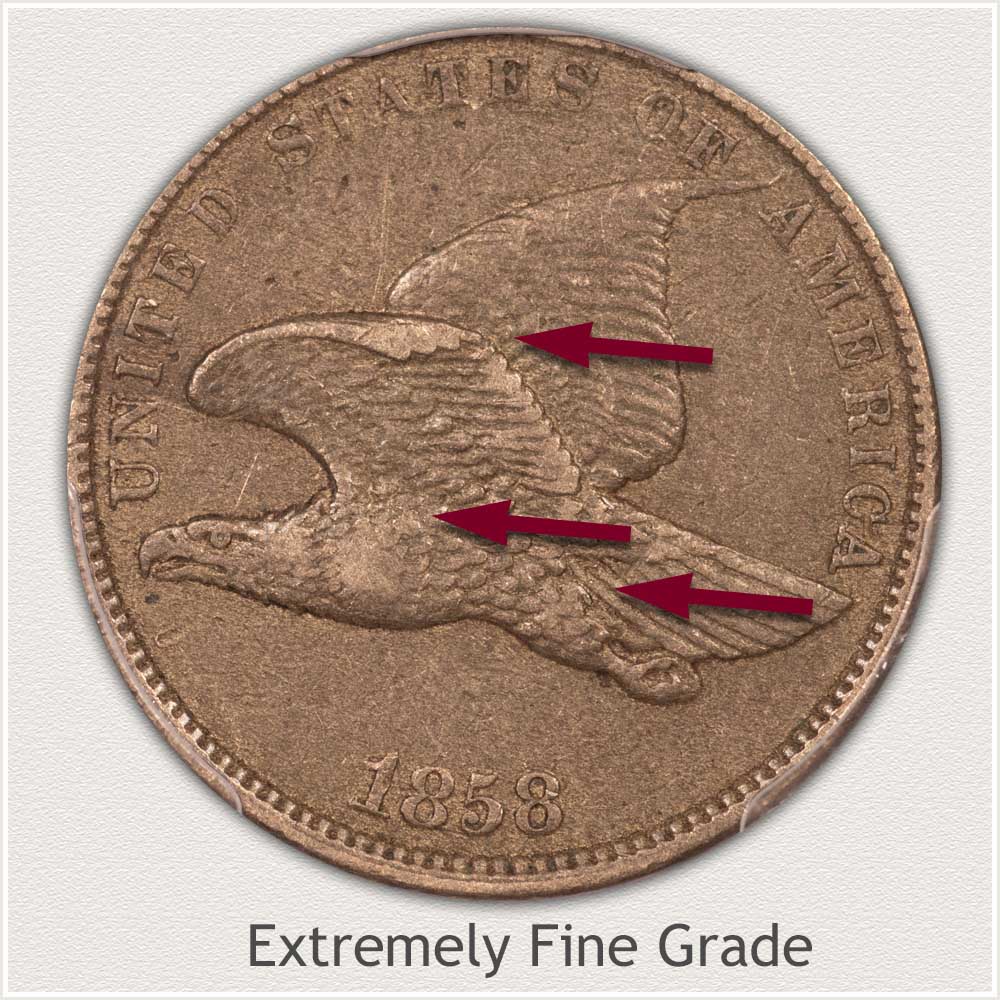
Obverse: Features Identifying Extremely Fine Grade: A small amount of wear visible indicates the Extremely Fine grade.
Found only is isolated areas, wear is just beginning to flatten the center of the eagle's breast just behind the neck feathers. Very tops of feathers are smooth and beginning to merge into a flat area.
A small area is smooth on the leg but is clearly separated from tail feathers and importantly feathers are distinct from the talons.
Leading edge of the left wing shows minor wear as well as the trailing feathers of the wing. Individual feathers along the trailing edge remain defined and separated.
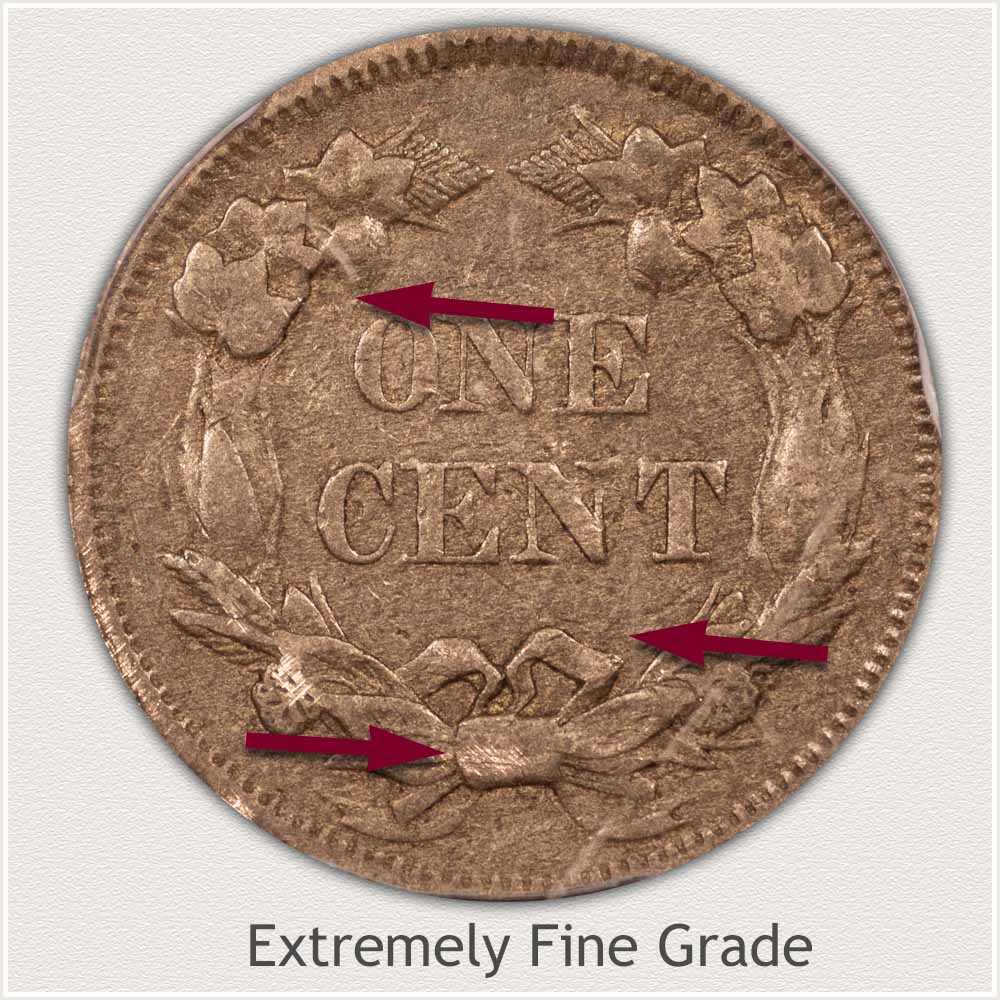
Reverse: Features Identifying Extremely Fine Grade: Design elements on the reverse are often softly struck creating difficulty judging wear accurately.
With softness of strike in mind, leaves on the sides of One Cent remain slightly contoured with a flat area within the center. A separating line remains from the lower leaves.
Central area of the knot is mostly smooth but edges are separated from the leaves on either side.
Waves within the upper loops of the ribbon remain showing a contour with minor flatness evident.
Fine Grade: Flying Eagle Cent
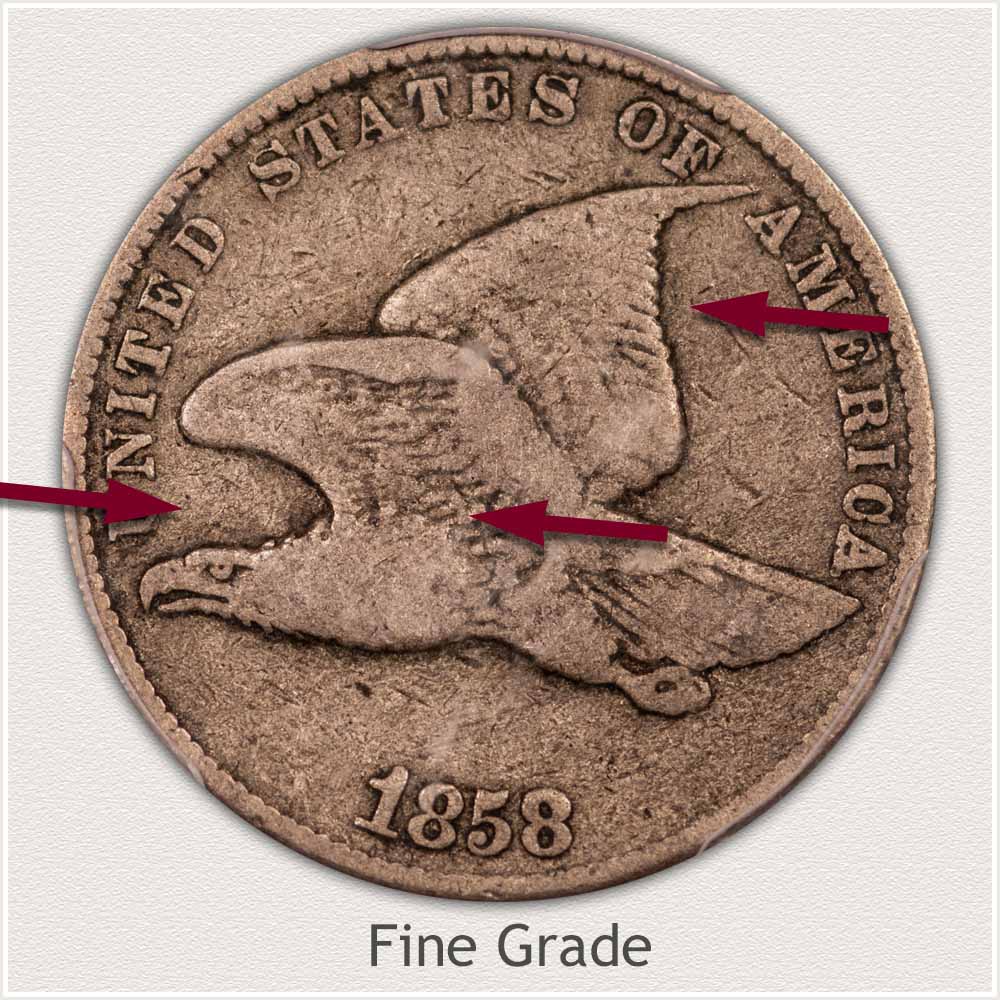
Obverse: Features Identifying the Fine Grade: Significant wear covers the entire eagle. Heavy wear is present; however, the eagle remains clearly defined.
A large flat area now represents the eagle's breast. Importantly, a few feather details are visible creating a separation from the leg.
Features of the eagle's head are bold with an eye clearly visible.
On the right wing, rows of feathers are separated vertically. Individual feathers must remain defined to edge of wing.
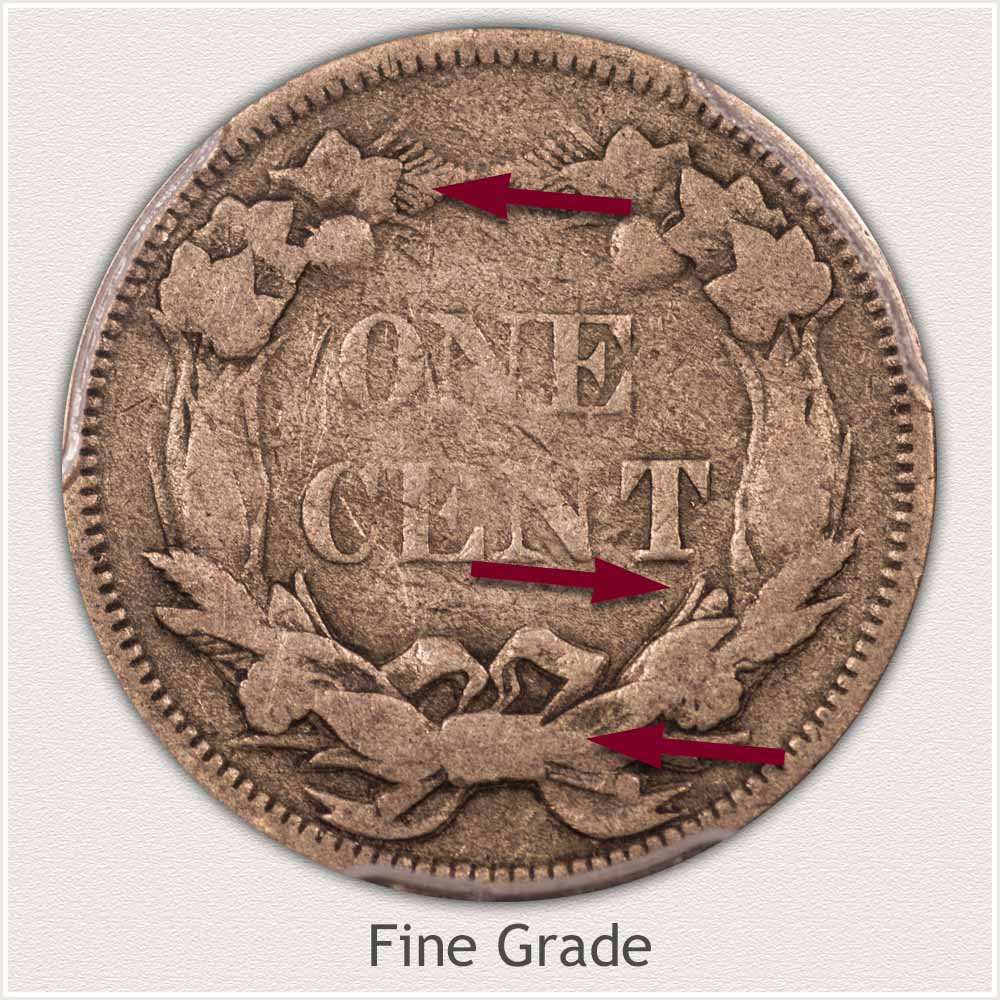
Reverse: Features Identifying the Fine Grade: Many areas of the wreath are flattened by heavy wear. A few elements if present indicate a cent in Fine grade.
Wheat grains are displayed on either side of the wreath in a line just below Cent. If these elements are separated from the ears of corn above, a Fine grade is possible.
Leaves towards the top have clear edges and are mostly defined from each other.
Central knot to the bow at the bottom remains defined. Only minor blending with leaves on either side is evident.
Overall appearance of the reverse in Fine grade is described as; flattened areas but each flat area is disconnected from others. Once smooth spots connect and cover the majority of the wreath a lower grade is assigned.
Good Grade: Flying Eagle Cent
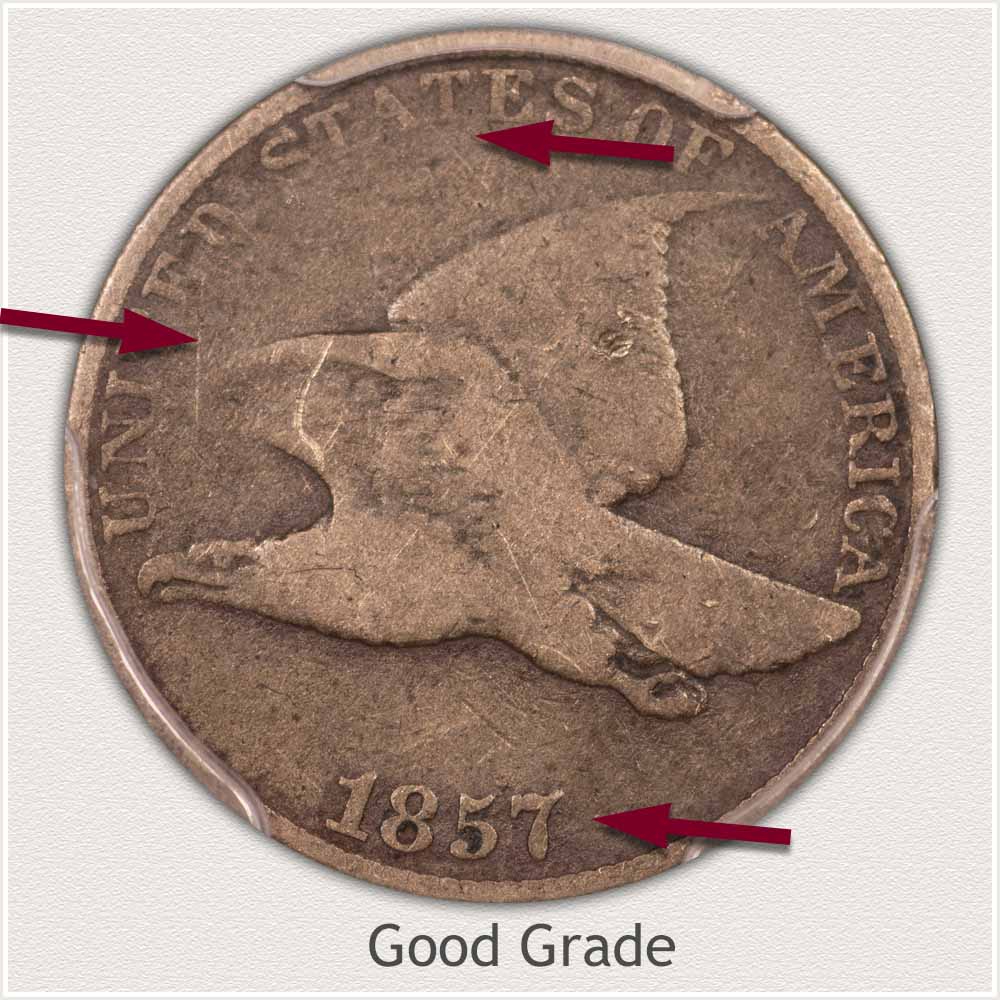
Obverse: Features Identifying the Good Grade: Heavy wear from circulation has removed most of the design elements.
Eagle is represented as only a profile with few central design elements remaining. Entire outline to eagle is visible although merging with the field is noted on the forward wing tip.
Legend above eagle must remain readable although very worn on many examples.
Importantly a clear date is required to achieve the good grade. The example displays a full rim indicating a strong strike and improves value and marketability.
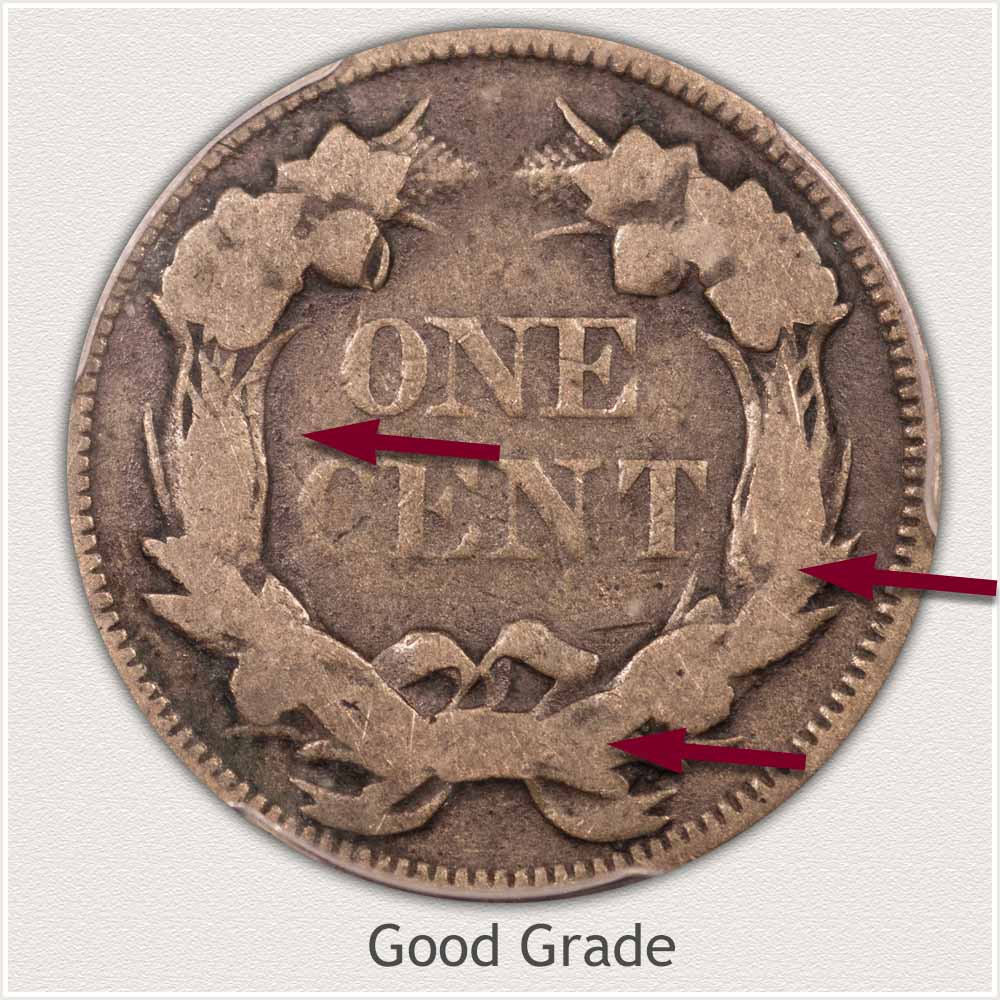
Reverse: Features Identifying the Good Grade: A key element helping identify the Good grade is when the bow has blended with the wreath. Overall, leveling of contours within the wreath is widespread.
From the bow upward; a connected flat area extends within the wreath. All design elements are smooth and merged. Once reaching this state of wear along with few features present in the upper part of the wreath, condition is now within the Good grade.
Step 3: | Recognize Special Qualities and Added Value
Recognizing Appeal of Flying Eagle Pennies to Collectors
Initial value of all coins is determined by date and a careful judgment of condition. The chart above highlights the value awarded to a desirable, well-preserved example. Collectors further consider a variety of aesthetics portrayed by old coins. Natural toning, boldness of strike and lack of distracting marks enhances the desirability of a coin.
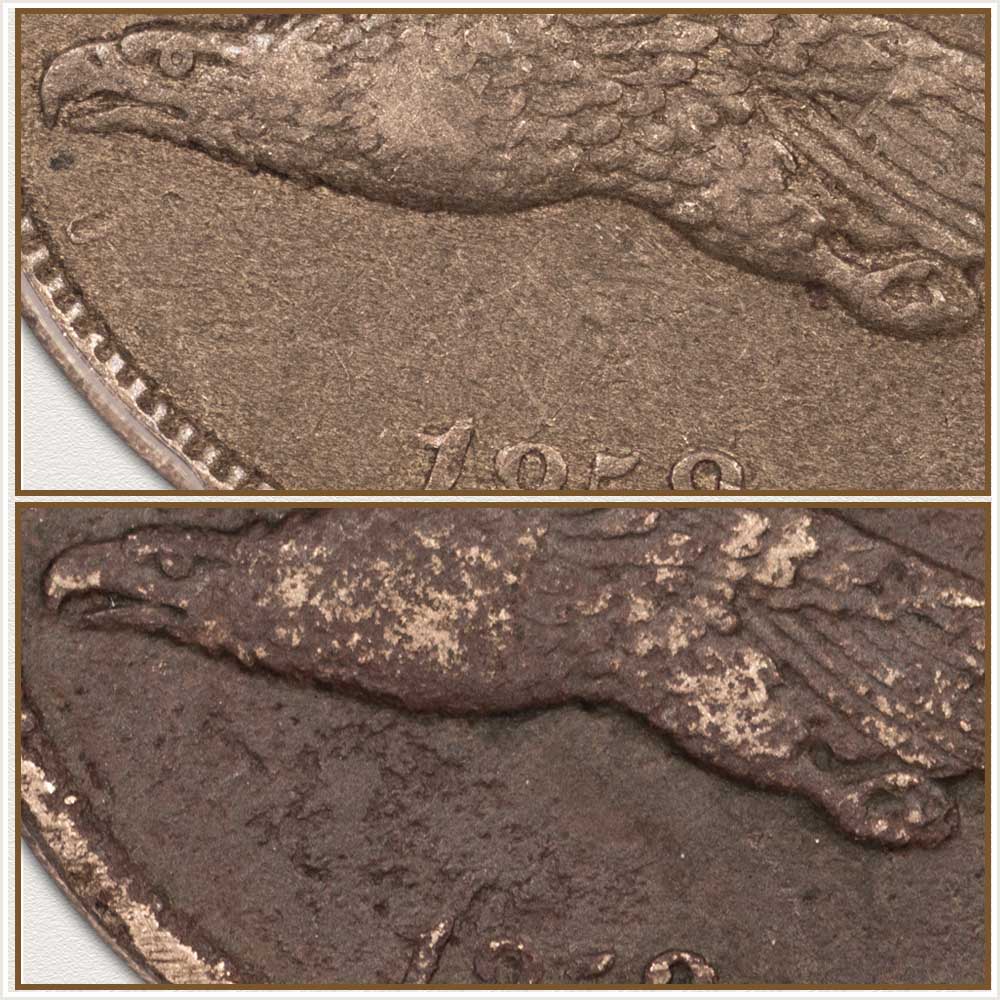
A prime focal point first observed on a flying eagle penny is the date, open field above, and head of the eagle.
Both coins pictured are very similar in the amount of wear to the surface. In this close-up view, preservation is very different for each coin. The first coin is a pleasing color, light tans with highlights. A mark free field is below the eagle. Well detailed features remain on the eagle's head, feathers and well struck talons.
The second example suffers from darkness of color, rough surface below the eagle and abrasions to the eagle. These problems all combine to lower eye appeal and desirability.
Often collected as a type example, many collectors seek one nice Flying Eagle cent to represent the series. Comparing and recognizing a few aesthetics identifies a sough after coin.
References
US Mint. Symbols on our Coins
https://www.usmint.gov/learn/history/us-circulating-coins
US Mint. Catalogue of Coins of the United States
https://nnp.wustl.edu/library/book/554591
US Mint. 1938 US Mint Annual Report
https://nnp.wustl.edu/library/publisherdetail/51
Coin Values | CoinStudy Articles
1856 Flying Eagle Cent - Why Such High Values?
A lofty value of the 1856 cent is caused first of all, by a very low mintage. This new design was struck as test examples and handed to congressmen, other prominent individuals and collectors at the time. 1856 was a limited production, not intended for circulation. Its purpose was to demonstrate the new size and design one cent.
A second major support to value is collectors consider an 1856 cent as part of a complete Flying Eagle cent collection. This is a big demand by many collectors on a small supply.
Condition is also playing a role in high values of all 1856 pennies. High condition coins survive today, cared for since receiving them. Collectors strive to obtain well preserved coins as part of collections. Thankfully these exist, although expensive. Additionally, some of these exhibition pieces did slip into circulation. When offered for sale these circulated Flying Eagle cents are still valued into the many thousands of dollars because of overall scarcity.
One word of caution. Authentication is a must for these high profile, valuable coins. Many attempts are made to deceive. Two leading services are used by collectors to authenticate and grade their coins. See PCGS and NGC as an introduction to the process.
1856 through 1858 cents stand out as sought-after collector coins because of the bold flying eagle design. And they represent the introduction of the modern small cent size.
Coin Value Guide | How to Value a Coin Collection
A step by step method combined with the coin value online guide identifies how to value a coin collection. Discover how much your box of old coins is worth.
Penny Values | Rare Pennies Have Outstanding Values
Penny values listed for the various series. From the earliest Half and Large cents, to Indian head pennies to the popular Wheat pennies of 1909 to 1958. Match you coins to the grading images and value charts. Some of these old pennies have amazing values.
An excellent picture index of all major US coin series. Compare and identify your coin to the picture, click on the image, and go immediately to your old coin value.
Understanding value of your flying eagle penny is a great first step to successfully selling these coins. Resources helping find markets is the next step.
Old US Penny Values are Rising
Coin values are determined by using the grading images to judge condition then checking the date and values on the charts provided. Discover all the rare varieties, dates and mintmarks.
★ Coin Values Discovery finds Flying Eagle Penny Values and...
All old US coin values. It is an excellent index with images and text links to all coin series, from Cents to Gold. Value charts, grading images and a step by step procedure uncovers how much your box of old coins is worth.
